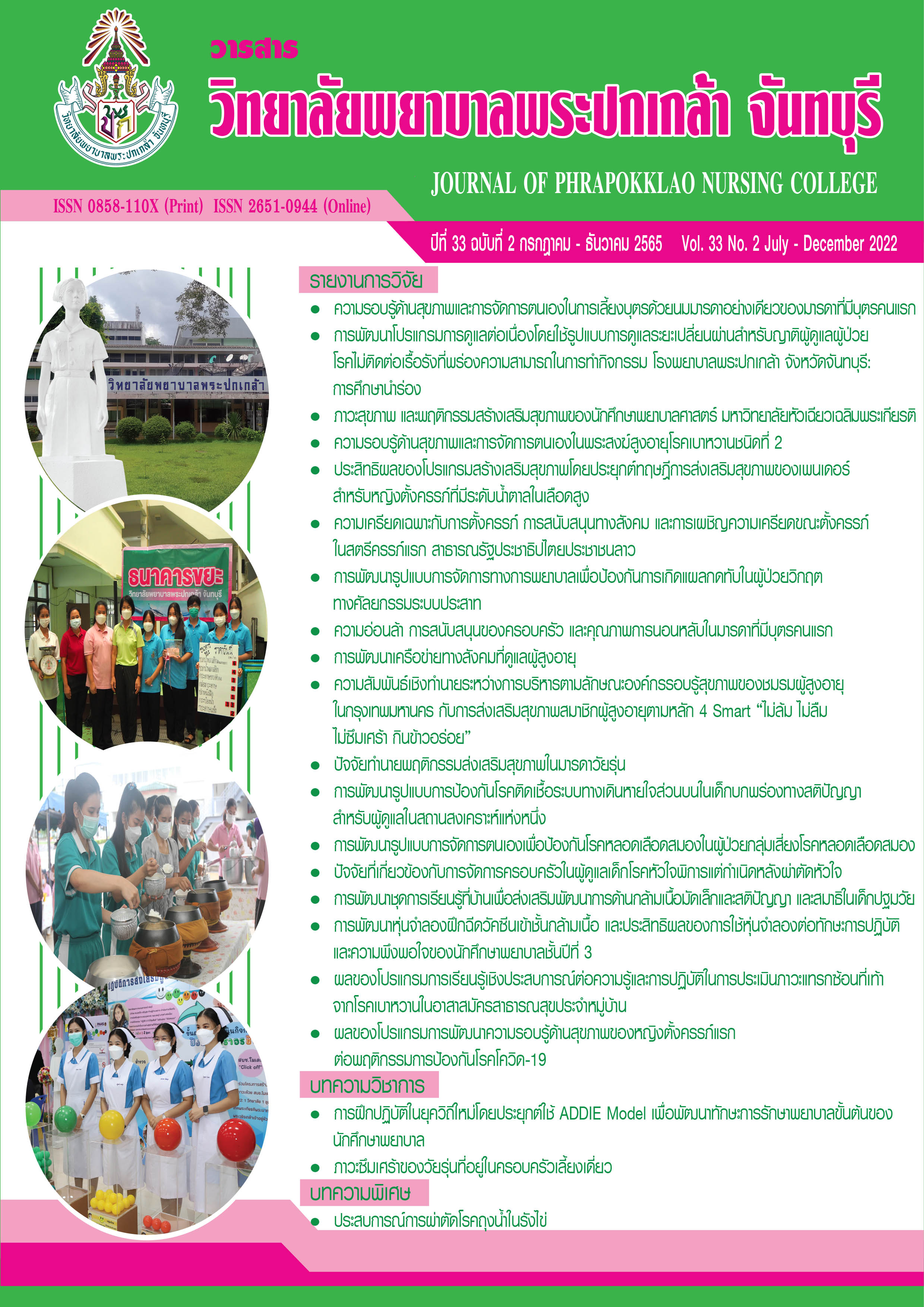Factors Predicting Health Promotion Behaviors among Adolescent Mothers
Keywords:
Adolescent mothers, Health promotion behaviors, Perceived health status, Perceived self-efficacyAbstract
This predictive correlational research aimed to explore factors predicting health promotion behaviors among adolescent mothers. The participants were 120 adolescent mothers who attended Maharaj Nakorn Chiang Mai Hospital, Chiang Mai Health Promotion Center Region 1 Hospital, Lamphun Hospital, and Lampang Hospital. The research instruments included the personal information questionnaire, the perceived health status questionnaire with reliability of .80, the perceived self-efficacy questionnaire with reliability of .90, the interpersonal influence questionnaire with reliability of .91, and the health promotion behaviors among adolescent mother questionnaire with reliability of .84. Data were collected from June, 2019 to February, 2020. Statistics used for data analysis included frequency, percentage, mean, standard deviation, Pearson’s product moment correlation, and stepwise multiple regression analysis.
The research results revealed that perceived health status and perceived self-efficacy were statistically significantly predicted health promotion behaviors among adolescent mothers at 70.10% (R2 = .701, p < .001). The most predicting factor was perceived self-efficacy (Beta = .776, p < .001) followed by perceived health status (Beta = .132, p < .05).
This research suggests that nurses should enhance perceived health status and perceived self-efficacy among adolescent mothers in order to raise their health promotion behaviors.
References
เจิดนภา แสงสว่าง. (2559). ปัจจัยที่เกี่ยวข้องกับพฤติกรรมส่งเสริมสุขภาพของมารดาวัยรุ่น (วิทยานิพนธ์ปริญญามหาบัณฑิต). มหาวิทยาลัยเชียงใหม่.
ชณิตา สุริอาจ, ปรีย์กมล รัชนกุล, และวนลดา ทองใบ. (2557). การรับรู้ภาวะสุขภาพ พฤติกรรมการดูแลสุขภาพ และความต้องการบริการสุขภาพของผู้ต้องขังที่มีความผิดปกติทางเมตาบอลิก. รามาธิบดีพยาบาลสาร, 20(3), 372–387.
ประจวบ แหลมหลัก, วัชรินทร์ คำมาเร็ว, ธวัชชัย เสาหิน, ทิพย์รวี สมบัติปัญญ์, สุรชัย ธิติมูล, และสงกรานต์ จันทร์ทะระ. (2556). การตั้งครรภ์ในวัยรุ่น: ปัญหาและแนวทางการแก้ไขทางสังคมวิทยา. วารสารการพยาบาล การสาธารณสุขและการศึกษา, 14(3), 3–11.
วรรณภา ศรีธัญรัตน์, ผ่องพรรณ อรุณแสง, พิมภา สุตรา, และเพ็ญจันทร์ เลิศรัตน์. (2555). เส้นทางสร้างสมรรถนะ สร้างเสริมสุขภาพองค์รวม. ขอนแก่น: โรงพิมพ์คลังนานาวิทยา.
สำนักงานกองทุนสนับสนุนการสร้างเสริมสุขภาพ. (2561). พฤติกรรมส่งเสริมสุขภาพของคุณแม่หลังคลอด ตอนที่ 1. สืบค้นจาก https://tinyurl.com/24npfu6e
สำนักอนามัยการเจริญพันธุ์ กรมอนามัย. (2562). สถานการณ์อนามัยการเจริญพันธุ์ในวัยรุ่นและเยาวชน ปี 2562. สืบค้นจาก https://tinyurl.com/bdcsstx3
สำนักอนามัยการเจริญพันธุ์ กรมอนามัย. (2563). ถอดบทเรียน พชอ.: ลดแม่วัยรุ่น. สืบค้นจาก https://tinyurl.com/3r73rjzw
สุจิตต์ แสนมงคล. (2559). การรับรู้ภาวะสุขภาพ แรงสนับสนุนทางสังคม และพฤติกรรมการดูแลตนเองของหญิงตั้งครรภ์วัยรุ่นครรภ์แรก จังหวัดภูเก็ต. วารสารวิชาการแพทย์เขต 11, 30(2), 105–114.
สุภาภรณ์ นันตา. (2560). อิทธิพลระหว่างบุคคล อิทธิพลของสถานการณ์ และพฤติกรรมส่งเสริมสุขภาพของมารดาวัยรุ่นหลังคลอด (วิทยานิพนธ์ปริญญามหาบัณฑิต). มหาวิทยาลัยเชียงใหม่.
Adams, L. (2000). Health promotion for adolescent mothers. Retrieved from http://www.epi.umn.edu/let/pubs/img/NMPA_preface.pdf
Cunningham, F. G., Leveno, K. J., Bloom, S. L., Spong, C. Y., Dashe, J. S., Hoffman, B. L., … Sheffield, J. S. (2014). Williams obstetrics (24th ed.). New York: McGraw-Hill.
Lowdermilk, D. L., Perry, S. E., Cashion, K., & Alden, K. R. (2012). Maternity and women’s health care (10th ed.). St. Louis: Elsevier Mosby.
Mallick, D. R. (2010). Perceived health status, perceived self-efficacy, and health promoting behaviors of Bangladeshi postpartum women (Master’s thesis). Prince of Songkla University. Retrieved from https://kb.psu.ac.th/psukb/bitstream/2010/7823/1/325993.pdf
Musavian, A. S., Pasha, A., Rahebi, S. M., Atrkar Roushan, Z., & Ghanbari, A. (2014). Health promoting behaviors among adolescents: A cross-sectional study. Nursing and Midwifery Studies, 3(1), e14560. doi:10.17795/nmsjournal14560
Pedhazur, E. J. (1997). Multiple regression in behavioral research: Explanation and prediction (3rd ed.). Orlando, FL: Harcourt Brace College.
Pender, N. J., Murdaugh, C. L., & Parsons, M. A. (2015). Health promotion in nursing practice (7th ed.). Stamford, CT: A Simson & Schuster.
Rahman, M. M., Haque, S. E., & Zahan, M. S. (2011). Factors affecting the utilisation of postpartum care among young mothers in Bangladesh. Health and Social Care in the Community, 19(2), 138–147. doi:10.1111/j.1365-2524.2010.00953.x
Raven, J. H., Chen, Q., Tolhurst, R., & Garner, P. A. (2007). Traditional beliefs and practices in the postpartum period in Fujian Province, China: A qualitative study. BMC Pregnancy and Childbirth, 7(1), 8. doi:10.1186/1471-2393-7-8
Save the Children. (2014). Save the children praises passage of bipartisan “Feed the Future” bill to fight child hunger and malnutrition. Retrieved from https://chrissmith.house.gov/news/documentsingle.aspx?DocumentID=397782
The Pennsylvania Child Welfare Resource Center University of Pittsburgh. (2005). Child and adolescent development. Retrieved from http://www.pacwrc.pitt.edu/Curriculum/CTC/MOD9-OLD/RsrcBk/RsrcBk.pdf
United Nations Population Fund. (2013). Motherhood in childhood: Facing the challenge of adolescent pregnancy. Retrieved from https://www.unfpa.org/sites/default/files/pub-pdf/EN-SWOP2013.pdf
World Health Organization. (2006). Reproductive health indicators: Guidelines for their generation, interpretation and analysis for global monitoring. Retrieved from https://apps.who.int/iris/bitstream/handle/10665/43185/924156315X_eng.pdf?sequence=1&isAllowed=y
World Health Organization. (2020). Adolescent birth rate (per 1,000 females aged 15–19 years). Retrieved from https://www.who.int/data/maternal-newborn-child-adolescent/indicator-explorer-new/mca/adolescent-birth-rate-(per-1-000-females-aged-15-19-years)?bookmarkId=9ecd7afb-4c65-477c-a4e4-b57047416831
Downloads
Published
How to Cite
Issue
Section
License
Copyright (c) 2022 JOURNAL OF PHRAPOKKLAO NURSING COLLEGE

This work is licensed under a Creative Commons Attribution-NonCommercial-NoDerivatives 4.0 International License.
เนื้อความ ข้อมูล และรายการอ้างอิงที่ผู้เขียนใช้ในการเขียนบทความเพื่อลงตีพิมพ์ในวารสารวิทยาลัยพยาบาลพระปกเกล้า จันทบุรี ถือเป็นความคิดเห็นและความรับผิดชอบของผู้เขียน คณะผู้จัดทำวารสารไม่จำเป็นต้องเห็นพ้องด้วยหรือร่วมรับผิดชอบ
บทความที่ได้รับการลงตีพิมพ์ในวารสารวิทยาลัยพยาบาลพระปกเกล้า จันทบุรี ถือเป็นลิขสิทธิ์ของวารสารวิทยาลัยพยาบาลพระปกเกล้า จันทบุรี หากหน่วยงานหรือบุคคลใดต้องการนำส่วนหนึ่งหรือทั้งหมดของบทความไปเผยแพร่ต่อเพื่อวัตถุประสงค์ใด ๆ จะต้องได้รับอนุญาตจากบรรณาธิการวารสารก่อน



